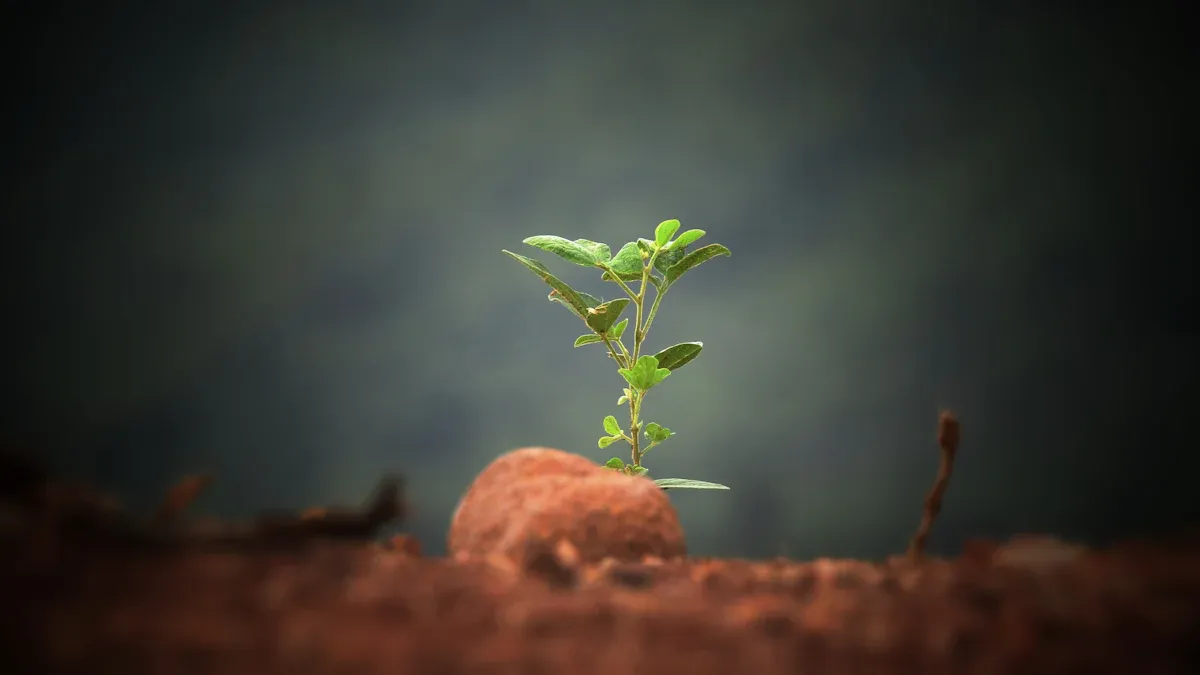
Photosynthesis is a remarkable process that plants and some microorganisms use to convert light energy into chemical energy, highlighting the importance of photosynthesis in our ecosystem. You may not realize it, but this process produces essential oxygen, which supports life on Earth. In fact, approximately half of the oxygen in our atmosphere comes from oceanic sources, primarily from plankton and algae. Understanding the importance of photosynthesis helps you appreciate how vital it is for maintaining the balance of our ecosystem and supporting all living beings.
Key Takeaways
Photosynthesis converts light energy into glucose, which is essential for plant growth and energy.
This process produces oxygen, which is vital for all living beings and helps maintain a balanced ecosystem.
Understanding photosynthesis can lead to better agricultural practices, increasing crop yields and food security.
Light and water are crucial for photosynthesis; without them, plants cannot grow effectively.
Improving photosynthesis efficiency can help combat food scarcity and support a healthier environment.
Importance of Photosynthesis

Photosynthesis Process
Photosynthesis is a complex process that occurs in plants, algae, and some bacteria. It allows these organisms to convert light energy into chemical energy. This process primarily takes place in the chloroplasts of plant cells, where chlorophyll absorbs light energy. You can think of chlorophyll as the green pigment that gives plants their color. It captures light energy, especially from blue and red wavelengths, which is crucial for initiating the light-dependent reactions.
During photosynthesis, plants take in carbon dioxide from the air and water from the soil. The overall chemical reaction can be summarized as follows:
6 CO2 + 6 H2O → C6H12O6 + 6 O2
This equation shows that carbon dioxide and water combine to produce glucose and oxygen. The glucose serves as an energy source for the plant, while oxygen is released as a byproduct. This process is not only vital for the plant’s growth but also essential for life on Earth.
Energy Conversion
The energy conversion that occurs during photosynthesis is remarkable. It involves two main stages: the light-dependent reactions and the light-independent reactions (Calvin cycle).
Light-Dependent Reactions: These reactions occur in the thylakoid membranes of chloroplasts. Here, chlorophyll absorbs light energy, which splits water molecules into oxygen, protons, and electrons. The energized electrons move through an electron transport chain, creating a proton gradient. This gradient is used to produce ATP and NADPH, which are energy-rich molecules.
Light-Independent Reactions: Also known as the Calvin cycle, these reactions take place in the stroma of chloroplasts. ATP and NADPH produced in the light-dependent reactions are used to convert carbon dioxide into glucose. This process is crucial for the plant’s growth, as glucose serves as a primary energy source.
The importance of photosynthesis extends beyond just plants. It plays a critical role in maintaining the balance of carbon dioxide and oxygen in the atmosphere. As plants absorb carbon dioxide and release oxygen, they help sustain life on Earth. This natural balance is vital for all living organisms, including humans.
Key Driver of Plant Growth

Role of Light and Water
Light and water are essential components of photosynthesis, acting as the primary drivers of plant growth. Without adequate sunlight, plants struggle to perform photosynthesis effectively. You might be surprised to learn that different plant species respond uniquely to varying light intensities. For instance, a study shows that certain species thrive under specific light conditions:
Light Intensity | Species | Photosynthetic Rate | Growth Metrics | Adaptation Mechanisms |
|---|---|---|---|---|
100% | A. mono | High | Increased SH, BSD, LN, LAPP, TDW | Increased MDA content |
75% | A. mono | Optimal | Higher growth metrics | Antioxidant regulation |
55% | A. pseudosieboldianum | Moderate | Greater growth advantages | Morphological plasticity |
20% | A. mono | Low | Decreased growth metrics | Imbalance of ROS metabolism |
This table illustrates how light intensity directly influences photosynthetic rates and growth metrics. As you can see, optimal light conditions lead to enhanced growth, while insufficient light can hinder development.
Water also plays a crucial role in photosynthesis. It serves as a reactant in the photosynthetic process, where it splits to release oxygen and provide electrons for energy production. Research indicates that adequate water supply significantly boosts photosynthetic efficiency in crops. Here’s a summary of how different water supplies impact crop growth:
Crop | Water Supply (mm) | Photosynthetic Product Allocation | Growth Response |
|---|---|---|---|
Maize | ≥300 | Increased allocation to roots | Enhanced aboveground biomass |
Wheat | 300–650 | Stable growth | Consistent yield under stress |
Maize | 300–800 | Optimal water use efficiency | Greater drought adaptability |
Wheat | N/A | N/A | N/A |
This table highlights that sufficient water not only supports photosynthesis but also enhances overall plant growth. When plants receive the right amount of water, they can allocate resources effectively, leading to better biomass production.
Carbon Dioxide Utilization
Carbon dioxide is another vital ingredient in the photosynthesis equation. During this process, plants absorb CO2 from the atmosphere and convert it into glucose, a crucial energy source. The overall reaction can be summarized as follows:
6CO2 + 6H2O + Light energy → C6H12O6 (sugar) + 6O2
This equation illustrates how carbon dioxide and water, with the help of sunlight, transform into glucose and oxygen. The glucose produced serves multiple purposes:
It provides energy for cellular respiration.
It can be stored as starch for later use.
It contributes to the formation of cellulose, which strengthens plant cell walls.
Research shows that increased carbon dioxide concentrations can enhance photosynthesis, leading to greater carbohydrate production and improved growth rates. For example, higher CO2 levels correlate with increased above-ground biomass in various plant species. This relationship emphasizes the importance of carbon dioxide in supporting plant health and productivity.
Photosynthesis and Plant Health
Cell Division and Differentiation
Photosynthesis plays a crucial role in overall plant health. It directly influences cell division and differentiation, which are essential for growth. When you think about how plants grow, consider that photosynthesis converts light energy into chemical energy. This energy fuels cellular processes, allowing plants to produce glucose. Glucose is vital for energy and serves as a building block for other important compounds.
Here’s a summary of how photosynthesis affects plant health:
Key Aspect | Description |
|---|---|
Role of Photosynthesis | Converts light energy into chemical energy, essential for plant growth and development. |
Production of Glucose | Provides energy for cellular operations and aids in the synthesis of plant structures. |
Environmental Factors | Factors like temperature, light intensity, and water availability affect photosynthetic efficiency. |
Importance for Ecosystem Health | Vital for plant life and overall ecosystem health, impacting food security and climate change. |
Healthy plants can better resist diseases and environmental stress. For instance, when plants face abiotic stress, they can convert excess light energy into thermal energy through a process called non-photochemical quenching (NPQ). This mechanism helps protect the photosystem II complex from damage. If plants maintain their photosynthetic efficiency, they can resist diseases more effectively. Research shows that disruptions in photosynthesis can increase susceptibility to diseases like black spot disease in Brassica species.
Impact on Food Security
The relationship between photosynthesis and food security is significant. Optimizing photosynthesis can lead to increased crop yields, which is essential for feeding the growing global population. Here are some key points regarding the impact of photosynthesis on food security:
Bioengineering efforts have proven to increase yields in major food crops, contributing to food security in impoverished areas.
Increasing barley productivity by 5-10% could yield an additional 8 million tons of grain annually, enhancing food security.
Strategies to enhance photosynthetic efficiency can significantly impact crop yield and help close the yield gap.
Enhancing photosynthetic efficiency is crucial for increasing crop yields and addressing food scarcity.
By improving photosynthesis, you can help ensure that plants grow healthier and produce more food. This is vital for maintaining a stable food supply and supporting global food security.
In summary, photosynthesis is vital for plant growth and the health of our ecosystems. It converts light energy into glucose, which fuels plant development. Here are some key takeaways:
Photosynthesis is crucial for converting light energy into glucose, essential for plant growth and cellular processes.
It produces oxygen, vital for life, and supports the metabolic needs of plants.
Understanding photosynthesis is key to enhancing agricultural productivity and addressing food security challenges.
By recognizing the importance of photosynthesis, you can appreciate its role in sustaining life on Earth and promoting a healthier environment. Embracing sustainable practices in agriculture will help maximize photosynthesis efficiency while protecting our planet. 🌱
FAQ
What is photosynthesis?
Photosynthesis is the process where plants, algae, and some bacteria convert light energy into chemical energy. They use sunlight, carbon dioxide, and water to produce glucose and oxygen.
Why is photosynthesis important for humans?
Photosynthesis produces oxygen, which you breathe. It also supports the food chain by providing energy for plants, which serve as food for animals and humans.
How do plants absorb carbon dioxide?
Plants absorb carbon dioxide through tiny openings called stomata, located on their leaves. This gas is essential for photosynthesis, allowing plants to produce glucose and oxygen.
Can photosynthesis occur without sunlight?
No, photosynthesis requires sunlight to provide the energy needed for the process. Without light, plants cannot produce glucose or oxygen effectively.
How does photosynthesis affect climate change?
Photosynthesis helps reduce carbon dioxide levels in the atmosphere. By absorbing CO2, plants mitigate climate change and contribute to a healthier environment. 🌍

